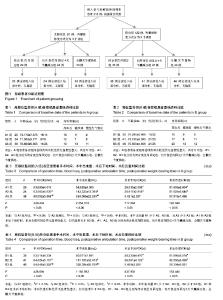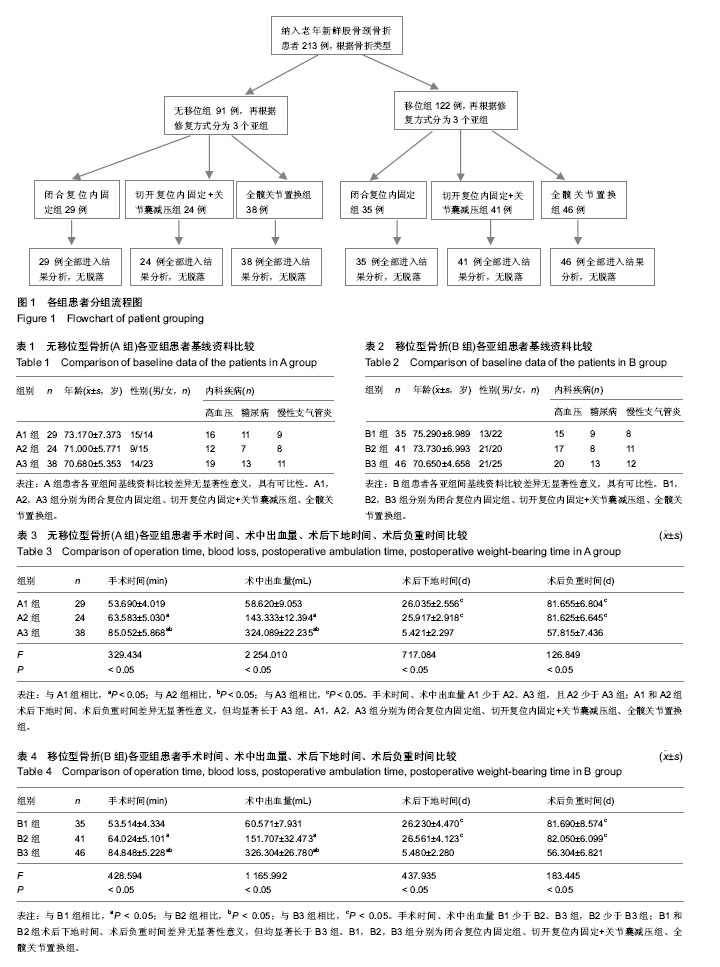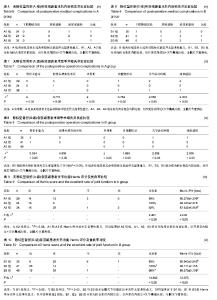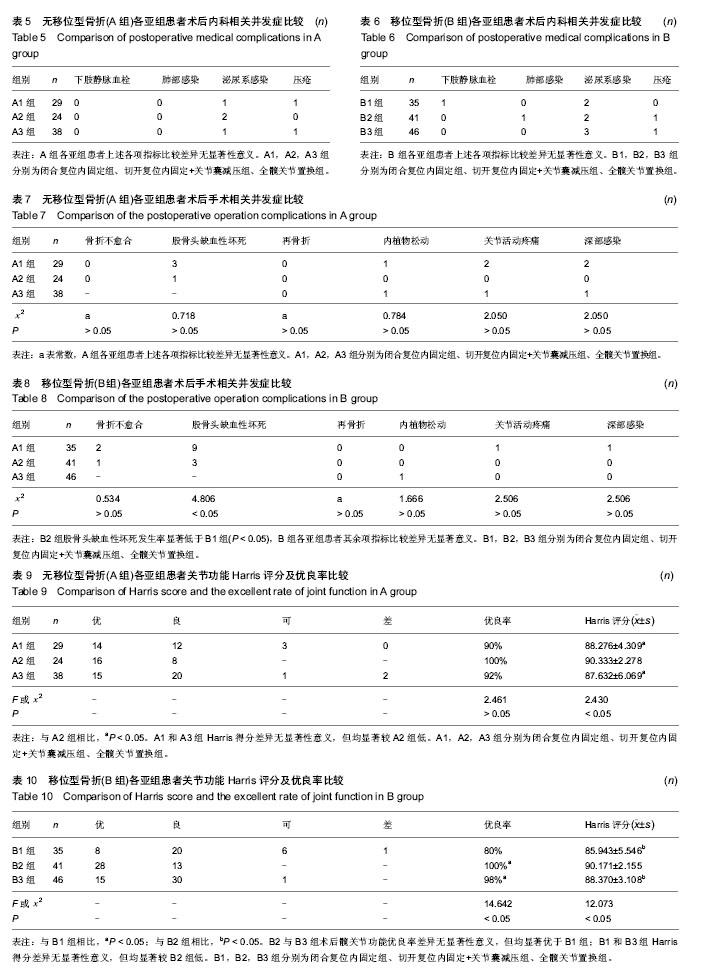| [1] 陈孝平,汪建平.外科学[M].北京:人民卫生出版社, 2013: 676-680.
[2] 杨宗酉,邢欣,张奇.股骨颈骨折治疗关键技术研究进展[J].中华创作杂志,2014,30(2):274.
[3] Frihagen F, Nordsletten L, Madsen JE. Hemiarthroplasty or internal fixation for Intracapsular displaced femoral neck fractures: randomised controlled trial. BMJ. 2007; 335(7632): 1251-1254.
[4] 王满宜,危杰.股骨颈骨折临床研究的若干问题新概念[J].中华创伤骨科杂志,2003,5(1):5.
[5] 贺良,王满宜.安全治疗高龄骨折[J].中华创伤骨科杂志,2004, 6(9):992-994.
[6] Schmidt AH, Leighton R, Parvial J, et al. Optimal arthroplasty for femoral neck fractures: is total hip arthoplasty the answer. J Orthop Trauma. 2009;23(6):428-433.
[7] Huang J, Jiang W, Xu R, et al. Primary gastric non-Hodgkin’s lymphoma in Chinese patients: clinical characteristics and prognostic factors. BMC Cancer. 2010; 1(1):358.
[8] Ismail AA, Pye SR, Cockefill WC, et al. Incidence of limb fracture across Europe: results from the European Prospective Osteoporosis Study(EPOS). Osteoporos Int. 2002;13(7):565-571.
[9] 王裕民,胡永成,李欣,等.老年伴有并存症的股骨颈骨折髋关节置换疗效分析[J].中国矫形外科杂志,2005,16(11): 1215-1218.
[10] 冼敬锋.全髋关节置换术与骨折内固定术治疗中老年股骨颈骨折的疗效分析[J].重庆医学,2013,42(13):1528-1529.
[11] 晓牧.全髋关节置换术和骨折内固定术治疗中老年人股骨颈骨折的疗效[J].中国老年学杂志,2014,34(7):1976-1977.
[12] Russell TA. Techniques in Orthopaedic Trauma. American Academy of Orthopaedic Surgeons, 2007.
[13] 危杰,王满宜.股骨颈骨折的内固定手术治疗[J].中华创伤骨科杂志,2003,5(1):64.
[14] 孙彦豹,王静,金宝成,等. 股骨头干三维互动闭合复位技术在股骨颈骨折治疗中的应用[J].中国骨与关节损伤杂志,2013, 28(10):908-910.
[15] Yu YX, Ma JZ, Zhu LB, et al. Failure of internal fixation on displaced femoral neck fractures in adults under fifty-fiveyears old. Zhongguo Gu Shang.2012;25(7): 542-545.
[16] 夏胜利,王秀会,王子平,等.股骨颈骨折空心螺钉内固定术中三种不同导针定位方法的疗效比较[J].中华创伤骨科杂志,2014, 16(5):444-447.
[17] 杨召,马信龙,张园,等.股骨颈骨折后股骨头坏死的原因分析[J].医学生物力学,2009,5(1):99.
[18] 成人股骨头坏死诊断标准专家共识(2012版) [J].中华骨科杂志,2012,32(6):606-608
[19] 刘志雄.骨科常用诊断分类方法和功能结果评定标准[M].北京: 科学技术出社,2005:268-270.
[20] 田敏,崔存宝,王东辰,等.老年股骨颈骨折人工髋关节置换67例临床报告[J].中国矫形外科杂志,2014,22(14):1325-1327.
[21] Ganzer D, Forke L, Irlenbusch U.Two-year follow-up of revision total hip arthroplasty using a ceramic revision head with a retained well-fixed femoral component: a case series. J Med Case Rep. 2014;8(1):434.
[22] Parker MJ, Gurnsamy K. Internal fixation versus arthroplasty forntraeapsular proximal femoral fractures in adults. Cochrane Database Syst Rev. 2006;(4): CD001708.
[23] Parker MJ, Gurnsamy KS, Azegami S. Arthroplasties (with and without bone cement) for proximal femoral fractures in aduhs. Cochrane Database Syst Rev. 2010;(6):CD001706.
[24] 徐明轩,黄野.老年股骨颈骨折的治疗进展[J].医学综述,2014, 20(14):2591.
[25] 白煜.老年股骨颈骨折两种手术治疗对比分析[D].大连医科大学,2013.
[26] 管伟荣.老年新鲜无移位型股骨颈骨折治疗的临床研究进展[J].当代医学,2014,20(26):362.
[27] Gao H, Liu Z, Xing D, et al. Which is the best alternative for displaced femoral neck fractures in the elderly? A meta-analysis. Clin Orthop Relat Res. 2012;470(6):1782.
[28] 朱蓝玉,秦彦国,王艳华,等.老年患者全髋关节置换观念[J].中国老年学杂志,2013,33(8):1945-1946.
[29] Shan L, Shao B, Graham D, et al. Total hip replacement: a systematic review and meta-analysis on mid-term quality of life. Osteoarthritis Cartilage. 2014;22(3):389-406.
[30] 郭学峰,王裕民.老年股骨颈骨折的治疗进展[J].中国矫形外科杂志,2014,22(16):1488-1491.
[31] 钱学峰,徐能.经皮空心螺钉内固定治疗股骨颈骨折[J].中华创伤骨科杂志,2013,15(5):453-454.
[32] 王清富,石峰,陈庄洪,等.影响空心加压螺钉治疗股骨颈骨折骨愈合的因素分析[J].中国中医骨伤科杂志,2013,21(8):34-36.
[33] 卢庆弘.影响空心加压螺钉治疗股骨颈骨折骨愈合的因素分析[J].中国骨伤,2012,28(12):1040-1044.
[34] Wazir NN, Mukundala VV, Choon DS. Early results of prosthetic hip replacement for femoral neck fracture in active elderlpatients.J Orthop Surg. 2006;14(1):43-46.
[35] 骆文勇,黄忠毅,傅军华,等.三种手术方法治疗老年股骨颈骨折126例疗效对比[J].中国骨与关节损伤杂志,2010,25(8): 729-730.
[36] 杨洋,林向进.877例髋部骨折患者发病情况及其流行病学特征分析[J].中华流行病学杂志,2014,35(4):446-448.
[37] 危杰,周力,王满宜.股骨颈骨折术后股骨头缺血坏死的发生及转归[J].中华创伤骨科杂志, 2005,01(25):1-5.
[38] 赵奇,刘世清,明江华.加压空心螺纹钉置入治疗成人股骨颈骨折:内固定失效分析[J].中国组织工程研究,2014,18(44): 7138-7143.
[39] 张庆天.Garden复位指数对空心钉治疗股骨颈骨折预后的影响[J].浙江临床医学,2013,15(1):76-77.
[40] Triantaphillopoulos PG, Panagiotopoulos EC, Mousafiris C, et al. Long-term results in surgically treated acetabular fractures through the posterior approaches. J Trauma. 2007;62(2):378-382.
[41] 罗正亮,尚希福,胡飞,等.全髋关节置换术治疗创伤性股骨头缺血性坏死的疗效分析[J].中华医学杂志,2014,(23):1773- 1776.
[42] 江辉,闫韵飞,赵建宁.3种手术方式治疗中老年股骨颈骨折疗效对比分析[J]. 医学研究生学报,2012,25(7):746-748. |



